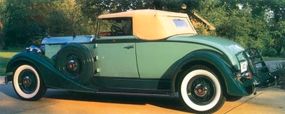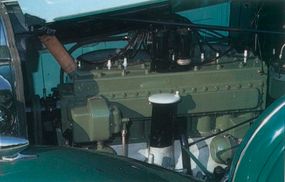The Packard Motor Car Company largely snubbed the model year change, designating its cars by "series," which often ran for far more than a year. But not in 1933, when the Tenth Series lasted only from January through August. There was good reason for that -- to debut new styling and mechanical updates for a new line, including the 1934 Packard Eight coupe-roadster and to take advantage saleswise of what looked like a hopeful easing of the Depression.
Advertisement
Packard needed the boost. The firm had lost $2.9 million in 1931 and $6.8 million in 1932. And the modest $506,433 profit recorded for 1933 turned into a whopping $7.3 million loss in 1934 (largely to tool up for the forthcoming middle-priced One-Twenty).
The Eleventh Series bowed on August 21, 1933, and enjoyed a 12-month run. It came in three series -- Eight, Super Eight, and Twelve -- on nine wheelbases. Amazingly, model offerings totaled more than 40, not counting nearly 20 "individual customs."

The magnificent Twelve, with prices starting at $3,820 and soaring beyond $7,700, found only 960 well-heeled buyers willing to indulge themselves in those tough economic times. The Super Eight, base priced at $2,950, didn't fare much better: Only 1,920 were built.
That left the Eight as Packard's bread-and-butter series, which ranged from $2,350 to $3,090 (a new Ford V-8 could be had for $505). The 129-inch-wheelbase 1100 Eight came only as a four-door sedan, the 141-inch 1102 as a seven-passenger sedan or limo.

The 1101 Eights, riding a 136-inch span, comprised 11 offerings. Among them was the coupe-roadster, model 719, which listed at $2,580 and weighed a hefty 4,430 pounds. Powered by Packard's smaller 320-cubic-inch, 120-horsepower straight eight, it averaged 10.5.
The coupe-roadster shared styling changes with the rest of the line: front fenders that curved down closer to the bumper; a wider, slotted front bumper; revised running boards with chrome-framed mats; new hood handles; "feathered" radiator cap (the "Pelican" ornament cost $20 extra); recontoured rear fenders; and the gas filler cap relocated behind the license plate.

Interiors were spruced up with more luxurious upholstery and higher front seat backs. Rearranged dash gauges made
room for centrally mounted controls for Packard's $79.50 deluxe radio.
But sales remained slow, and with the more extensively revised Twelfth Series on the way Packard slashed prices on June 21, 1934, resulting in a $2,180 tab for the dashing coupe-roadster. Even with that,
total Eight output came to just 5,120 units.
No matter, the excellence of these cars has long been recognized -- they carry full Classic status with the Classic Car Club of America.
The coupe-roadster seen here has covered 84,000 miles. Flaunting Trippe lights, side-mounted spares, and luggage rack, it is a testament to the quality and style of the cars that once rolled out of Packard's East Grand Boulevard factory in Detroit.
Advertisement
